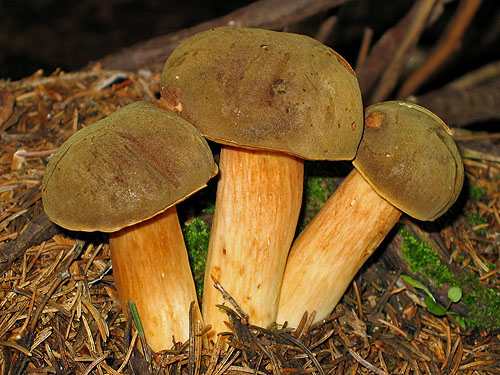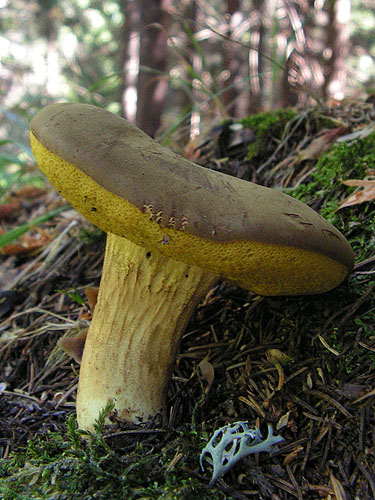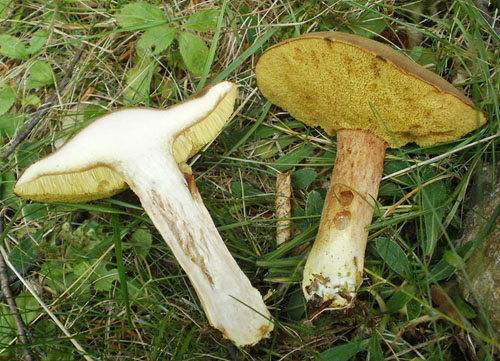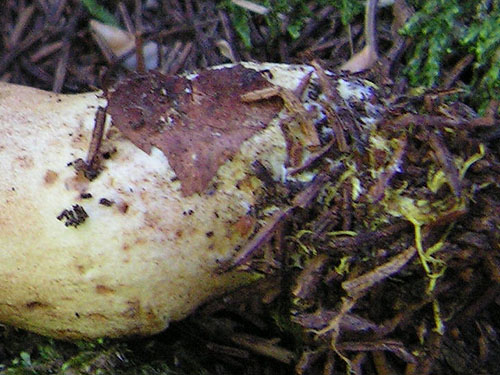Xerocomus Quél.
Recent molecular studies have shown that Xerocomus in its current circumscription is likely an artificial grouping and it is possible that it will be split at some point into smaller genera. Molecular studies also have changed our understanding about the species of xerocomoid boletes showing that morphological features are quite variable in this group. Not only microscopic study is essential for determination, but scanning electron microscope will be often needed in this “genus” as the spore ornamentation is not always seen under ordinary light microscope. Do bear in mind that macroscopic characters, such as colours, cracking cuticle, etc., tend to intergrade between the different species. Note that Boletus impolitus and Boletus depilatus that were shown to be close to Xerocomus subtomentosus and its allies, are here retained in Boletus for practical reasons. The same applies also for Phylloporus pelletieri, placed here in a genus of its own, but being also close to Xerocomus subtomentosus group.
Although large reference list will be found under most of the species, one should always consult Ladurner & Simonini (2003) having in mind that there are some new species (X. chrysonemus, X. marekii, X. silwoodensis) described after this otherwise superior book was printed. Useful keys, covering most of the European xerocomoid boletes (except some southern taxa) are provided by Knudsen & Vesterholt (2008), Hills (2008) and Kibby (2011), the later also featuring an excellent comparison chart.
Fruitbody medium to small sized, boletoid, without veil and ring. Stipe solid, often tapering towards the base. Flesh variously coloured, changing or not when exposed to air. Tubes not separable from each other, instead tearing apart. Pores usually angular.
Xerocomus ferrugineus (Schaeff.) Alessio
Description
Cap up to 12 cm, at first hemispherical, later convex to flattened, colour very variable, yellowish ochraceous, ochraceous, pale to dark brown or brick coloured, often with olivaceous tint, sometimes entirely olive green coloured, dry, felty, sometimes cracking and yellowish or whitish flesh is then seen in the cracks. Stipe cylindrical or spindle-shaped, tapered towards the base, pale yellow or yellow, sometimes becoming brownish or rusty, sometimes striate, often covered with scattered fine brownish granules, sometimes forming dotted network, unchanging when bruised; basal mycelium lemon yellow. Tubes pale yellow to yellow, more olivaceous with age, blueing or not blueing when injured. Pores concolorous with the tubes, blueing or not when bruised. Flesh white, sometimes yellowish above the tubes and in the stipe base, unchanging when exposed to air. Smell not distinctive. Taste slightly acid. Spores 10–16.5 × 4–6 μm, smooth. Pileipellis trichoderm of septate hyphae of cylindrical, smooth or nearly smooth cells.
Habitat. Mainly in coniferous or mixed forests, mycorrhizal mostly with spruce (Picea), but also with beech (Fagus), birch (Betula), bearberry (Arctostaphyllos) or dwarf willows (Salix herbacea, S. repens).
Distribution. In Europe widespread, but out of any doubt in the past confused with Xerocomus subtomentosus.
Similarity. Xerocomus ferrugineus is most similar to Xerocomus subtomentosus, but the later has pinkish to pinkish brown flesh in the stipe base, that is usually blueing in the cap. The basal mycelium in Xerocomus subtomentosus is whitish instead of the striking lemon yellow mycelium of X. ferrugineus.
Photographs

Fruitbodies of Xerocomus ferrugineus. Note the rusty coloured stipe. (photo B. Assyov)

Typical fruitbodies of Xerocomus ferrugineus with caps showing olive tint. (photo B. Assyov)

Fruitbody of Xerocomus ferrugineus. Note the ribs on the stipe and the resemblance with X. subtomentosus. (photo I. Assyova)

Sectioned fruitbody of Xerocomus ferrugineus. Note the white unchanging flesh, which is one of the distinguishing features of this species. (photo R. Vassilev)

Yellow basal mycelium of Xerocomus ferrugineus. (photo I. Assyova)
Important literature
Breitenbach J. & Kränzlin F. 1991. Pilze der Schweiz. Bd. 3(1). Röhrlinge und Blätterpilze. Verlag Mykologia, Luzern.
Engel, H., Dermek, A., Klofac, W., Ludwig, E. & Brückner, T. 1996. Schmier – und Filzröhrlinge s. l. in Europa. Die Gattungen Boletellus, Boletinus, Phylloporus, Suillus, Xerocomus. Verlag Heinz Engel, Weidhausen b. Coburg.
Estadès, A. & Lannoy, G. 2004. Les bolets européens. – Bulletin Mycologique et Botanique Dauphiné-Savoie 44(3): 3–79.
Galli, R. 1998. I Boleti. Atlante pratico-monographico per la determinazione dei boleti. Edinatura, Milano.
Gelardi, M. 2011. A noteworthy British collection of Xerocomus silwoodensis and a comparative overview on the European species of X. subtomentosus complex. – Bolletino dell’ Associazione Micologica ed Ecologica Romana 84: 28–38.
Hills, A.E. 2008. The genus Xerocomus. A personal view, with a key to the British species. Field Mycology 9(3): 77–96.
Knudsen, H. & Vesterholt, J. [eds.]. 2008. Funga Nordica. Nordsvamp, Kopenhagen.
Ladurner, H. & Simonini, G. 2003. Xerocomus s.l. – In: Fungi Europaei. Vol. 8. Pp. 1–527. Edizioni Candusso, Alassio.
Lannoy, G. & Estadès, A. 2001. Les Bolets. Flore mycologique d’Europe. Documents Mycologiques Mémoire Hors série no. 6. Pp. 1–163. Association d’Écologie et de Mycologie, Lille.
Šutara, J., Mikšík, M. & Janda, V. 2009. Hřibovité houby. Čeled’ Boletaceae a rody Gyrodon, Gyroporus, Boletinus a Suillus. Academia, Praha.
Watling, R. & Hills, A.E. 2005. Boletes and their allies (revised and enlarged edition). – In: Henderson, D.M., Orton, P.D. & Watling, R. [eds]. British Fungus Flora. Agarics and boleti. Vol. 1. Royal Botanic Garden, Edinburgh.